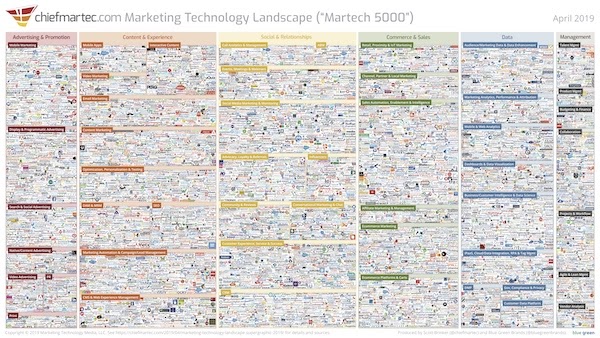You’re a B2B Startup with No Product Yet. Should You Do PR?

I’d say that nine out of 10 times I have a call with a B2B startup founder, I tell them this: It’s too early to hire us, but it’s never too early to start PR. And to help them get started, we have tons of resources on this very blog, including one of our most popular posts, “DIY PR for Startups.”
Most of those early stage B2B startups we push to DIY have a product ready to push out. It may not yet have product-market fit, but there’s something there and ready to talk about.
But what if you don’t have a product yet? Should you start a DIY PR effort or just lay low until your product is ready?
These are good questions. Here’s when you should consider PR:
When You’re Entering a Crowded Space
Let’s say you’re a martech startup and this well-known infographic from chiefmartech.com is keeping you up at night:
 These are the 5,000 known startups you’ll soon be going up against, so just imagine how many other martech startups are where you are – still building their product and not yet known.
These are the 5,000 known startups you’ll soon be going up against, so just imagine how many other martech startups are where you are – still building their product and not yet known.
With so much noise it will take a long time to break through when you’re finally ready to launch, so starting early – even if just via quickie intro emails to reporters and follow-ups over time – makes a ton of sense.
Here are two things you can do right away:
- Build a media list – take the time to find the right targets and never spam reporters.
- Build relationships – start off with a “hi there,” not a “buy here.”
When Recruitment Is Critical
Not every B2B startup can have an MVP up and running in a month or two and a beta version out soon after. Some require a ton of R&D and engineering super-power.
For this kind of startup, the biggest marketing objective is recruiting, and PR is incredibly useful for attracting talent.
Because top talent wants to work with top talent, here are some of things you can do:
- Introduce your management team.
- Spotlight your best players.
- Talk about your recruiting successes.
When You’re Brand New and Customer Education Is a Big Deal
Some startups have it pretty easy when it comes to explaining what they do: “We’re Uber for dog walkers.”
But “big idea” startups, especially when they’re B2B, are introducing completely new ways of looking at the world, with new technologies, business models, and philosophies.
These startups need to start explaining themselves sooner rather than later. They need to start talking about the problems they will solve and why their innovation is the right way to solve it.
Let’s say you’re building an AI SaaS product to solve supply chain problems in manufacturing. Here are two quick ideas:
- Reach out to the editor of a top manufacturing news site and offer to write an article on how AI is well suited to tackle supply chain issues.
- Pitch yourself to an AI-focused podcast, offering to share your insights about AI’s transformative potential in manufacturing.
When the Sales Cycle Will Be Long
Not every B2B startup is Slack, where a single employee can easily swipe the company card and get started. Some of them are so innovative that companies don’t have a category in their budget for it. Some require enormous financial investments.
If that’s the case for you, start that sales cycle as early as possible. Use PR to talk about the problem you’ll solve, to build awareness for your vision of the solution, and to establish trust and credibility before you ask for a signed contract.
Something you can do right away is pitch yourself to an industry trade publication as a contributor for articles that cover topics for each stage of what you expect to be the buyer’s journey:
- A broad overview of the problems you’re aiming to solve – “Industry X Has to Tackle Problem Y Before True Growth Can Occur”
- Why your underlying approach makes sense for tackling those problems – “Why Technology X May Be the Solution for Industry X’s Problem Y”
- How to evaluate technologies when trying to tackle a problem – “Technology X: How to Know if Vendor X Can Really Fix Problem Y”
When the Trend Is Already Growing
We all know the story of a startup founder, deep at work on a super secret pre-launch product, who wakes up one morning to see a brand new competitor getting press for a funding round (here's a whole post about what to do if that happens by Chicago startup guy Aji Abraham).
Rather than freak out and panic, that founder should remember what a wise client of mine once said:
“When the circus comes to town, all balloon vendors do well.”
So yes, you have a competitor, but that’s not a bad thing. It’s evidence that you’re onto something. Here’s what to do:
- Search for the reporters who covered that startup, and tell them about yours (read the media list building advice first; just because a reporter wrote about a competitor doesn’t mean they might want to write about you).
- When introducing your startup, don’t be afraid to name your competitors. Reporters often want evidence of a trend before writing about a new innovation or startup, and by getting yourself alongside your bigger competitors you’ll have the opportunity to differentiate.
So Go On, Get the Word Out
B2B startups need all the help they can get. They’re selling to large risk-averse companies, creating new categories companies have never budgeted for, spending years building a product before the first paying customer, and often selling unproven potential with a large price tag.
This can make it seem futile to start getting the word out too soon.
But it’s not.
The best time to plant a tree was 30 years ago, and PR is much the same way. The clock is ticking, and you need every minute.
Onward and Upward!







